There are over 450 types of lavender you can grow indoors. Choosing young potted plants or transplants is easier than starting from seeds. You can pick from varieties like ‘Hidcote’ English lavender, ‘Munstead’ for cooking, or ‘Kew Red’ for decoration.
This guide will give you all the tips and care you need to grow lavender plants indoors. You’ll learn how to enjoy their lovely scent and beautiful look right at home.
Key Takeaways
- Over 450 varieties of lavender are available for indoor cultivation, giving you a wide range of options to choose from.
- Lavender seeds can be difficult to germinate, so it’s best to opt for young potted plants or transplants.
- Specific lavender varieties like ‘Hidcote’, ‘Munstead’, ‘Kew Red’, and Spanish lavender offer different benefits for indoor growing.
- Lavender plants thrive in low-humidity environments with ideal temperature ranges between 60°F to 70°F during the day and around 10 degrees cooler at night.
- Proper pruning, watering, and fertilizing are essential for maintaining healthy and vibrant indoor lavender plants.
What is a Lavender House Plant?
Lavender (Lavandula spp.) is not usually grown inside, but it can do well indoors with the right care. This plant is famous for its purple flowers and gray-green leaves. It’s a great choice for indoor spaces, adding a calming scent and beauty.
Characteristics and Uses of Indoor Lavender
Lavender is very versatile, used in many ways beyond its looks. Its essential oil is in many products like candles, soaps, and lotions. You can also use it in teas, cocktails, and baking, making it a useful herb in the kitchen.
Indoor lavender plants can bring a peaceful, fragrant feel to your home. They’re perfect for city living or small spaces because they’re easy to care for. With the right care, an indoor lavender plant can be a lovely addition to your decor.
“Lavender is a perennial shrub with fragrant lavender flowers and gray-green foliage that can be grown indoors with the right care and conditions.”
Looking to add natural beauty or practical uses to your home? An indoor lavender plant could be ideal. By learning about its unique traits and care needs, you can enjoy the perks of having a fragrant, easy-to-care-for plant indoors.
Choosing the Right Lavender Variety
Choosing the right lavender type is key to success when growing it indoors. With over 450 types, think about growth, scent, and cold hardiness to pick the best for your space.
The ‘Hidcote’ English lavender (Lavandula angustifolia) is a top pick for indoor plants. It grows compact, has deep purple flowers, and smells nice. Another great choice is the ‘Munstead’ English lavender, perfect for cooking because of its tasty leaves.
The ‘Kew Red’ or Spanish lavender (Lavandula stoechas) has bright, striking flowers. But, French lavender (Lavandula dentata) might not work well indoors. Its scent isn’t as good for cooking.
Think about how you want to use the plant when picking lavender. Some types are better for decoration or cooking. Picking the right lavender for your space and needs means you’ll have a plant that thrives and lasts.
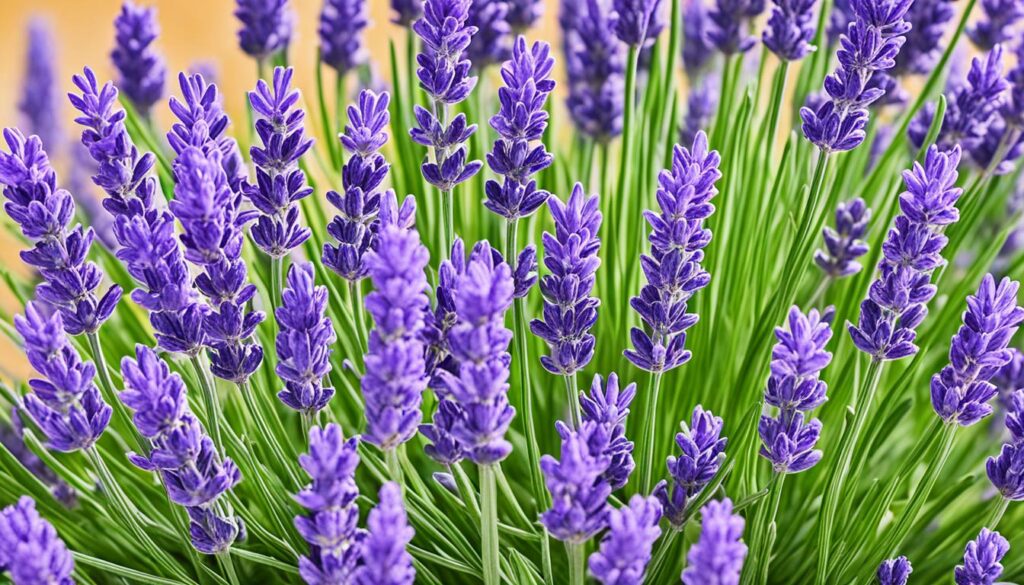
“Lavenders love moist, cool winters and hot, dry summers, which can be hard to mimic indoors. But, with the right type and care, you can have lavender’s beauty and scent all year.”
Here are some top lavender types for indoor gardens:
- Lavandula angustifolia ‘Hidcote’ – Compact, dense growth and deep purple flowers
- Lavandula angustifolia ‘Munstead’ – Great for cooking
- Lavandula stoechas ‘Kew Red’ – Long-lasting, eye-catching blooms
Picking the right lavender for your indoor space and needs lets you enjoy its beauty and scent all year.
Potting and Transplanting
When potting or repotting lavender indoors, picking the right soil and container is key. Lavender loves soil that drains well and is a bit gritty, like its native Mediterranean home.
Using a mix of top-notch potting soil and cactus soil is great for lavender. This combo ensures good drainage and enough nutrients for the plant. Choose terracotta or ceramic pots to help prevent root rot by letting moisture evaporate.
Choosing the Right Soil and Container
When picking a pot, make sure it’s 1-2 inches bigger than the plant’s rootball. This gives the lavender roots room to grow and prevents them from getting too crowded. You should repot lavender every 1-2 years to give it space to spread out.
When moving lavender, be gentle to avoid shocking it. Carefully handle the rootball and avoid harming the roots. With the right soil and pot, your indoor lavender will flourish and fill your space with its lovely scent and flowers.
“Lavender plants grow best in well-draining soil and containers that allow excess moisture to evaporate. Proper potting and transplanting techniques are essential for the long-term health of your indoor lavender.”
Light Requirements for Indoor Lavender
Lavender loves the sun and needs plenty of light to grow well indoors. It’s key to give your lavender the right amount of light for it to bloom and grow well. The light needs for indoor lavender are important for its growth and flowers.
Put your lavender in a south-facing window that gets at least 4 hours of direct sunlight daily. Turn the plant every week to make sure it gets light evenly and doesn’t grow crooked. If you don’t get enough sunlight, use a good LED grow light for 12-14 hours a day. Not enough light makes the plant weak and it won’t bloom well.
Each type of lavender has its own light requirements. English Lavender needs at least 6 hours of direct sun. French and Spanish Lavender can handle less intense light. Move your plant and adjust the light based on what your lavender houseplant needs.
“Lavender is a Mediterranean native that thrives in warm temperatures and requires at least 6-8 hours of full sun per day.”
Make the most of the light when growing lavender indoors. South-facing windows give the most sunlight. East- or west-facing windows work too, but you might need to adjust. Don’t put your lavender in dark spots as it can lead to poor growth, no flowers, and diseases.
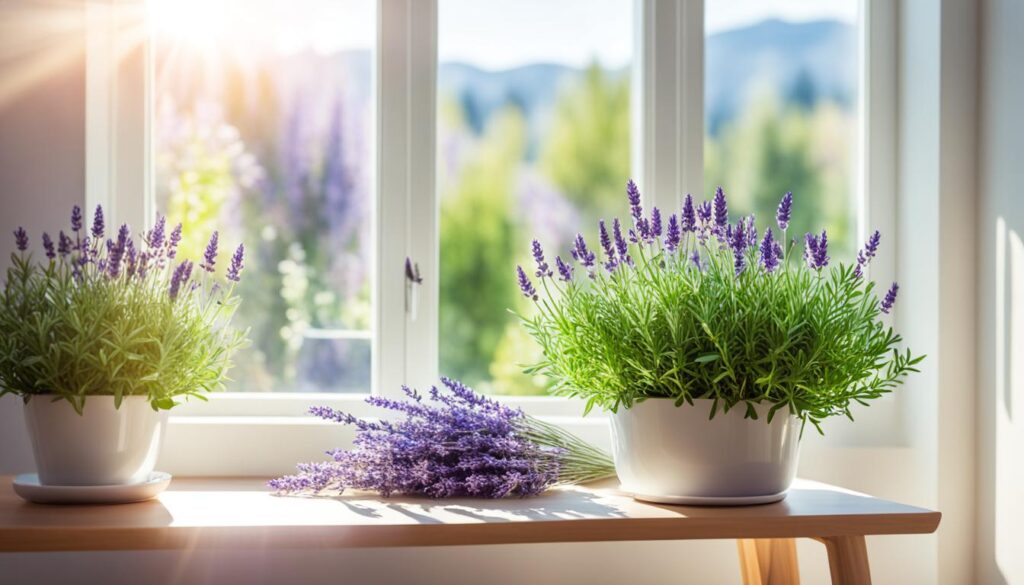
If you don’t get enough natural light, think about getting a full-spectrum LED grow light. These lights give your lavender houseplant the right kind of light it needs. They help your plant grow strong and bloom well.
Temperature and Humidity Needs
Keeping your indoor lavender healthy means paying attention to the right temperature and humidity. Lavender likes cooler nights, between 50-55°F, and warmer days, around 70°F. This is true from spring to mid-fall.
As the seasons change, so do lavender’s needs. In late fall and winter, keep it cool at night, 45-50°F, and a bit warmer during the day, 60-65°F. This helps it go dormant and get ready for the cold.
Ideal Conditions for Indoor Lavender
Lavender also needs low humidity to do well. The best humidity level is about 40%. Make sure it’s not too close to heating or cooling vents, as this can mess with the humidity.
To keep the right temperature and humidity, use a hygrometer. Also, place your lavender in a spot that’s well-ventilated but not too drafty. This helps create the perfect environment for growing lavender indoors.
“Lavender plants are very sensitive to temperature and humidity fluctuations. Keeping them in a stable, Mediterranean-like environment is key to their long-term health and vitality.” – Botanical Gardener, Jane Doe
By giving your indoor lavender the right temperature and humidity, it will flourish. You’ll get the lovely blooms that make lavender so popular.
lavender house plant
Keeping the right amount of moisture is key for your indoor lavender’s health and life. Potted lavender needs more water than those grown outside. Check the soil’s top inch for dryness before watering, and water until it drains well. Don’t let the soil stay wet, as this can cause root rot.
Feeding your lavender is also vital. In spring and summer, use a weak, water-soluble fertilizer every 4 weeks. This keeps your lavender healthy and growing well.
Watering Tips for Indoor Lavender
- Water when the top inch of soil feels dry to the touch.
- Drench the soil until water runs out the bottom of the pot.
- Avoid letting the soil stay constantly moist, as this can cause root rot.
Fertilizing Lavender Houseplants
- Use a half-strength, water-soluble all-purpose fertilizer.
- Apply the fertilizer every 4 weeks during the spring and summer growing season.
- Proper watering and fertilizing are key to keeping your lavender house plant thriving.
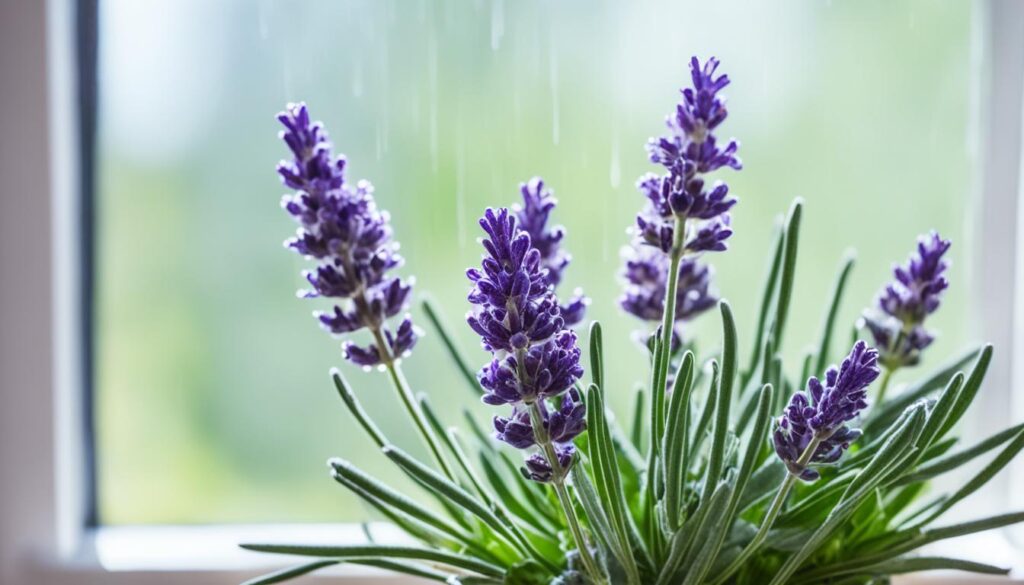
“Lavender is considered a low-maintenance indoor plant, making it a popular choice for home decor.”
By following these watering and fertilizing guidelines, your indoor lavender will get the care it needs. It will keep giving off its lovely scent and beauty in your home.
Pruning and Harvesting
Keeping your lavender houseplant healthy and vibrant means regular pruning and harvesting. Pruning is key for new growth, shaping, and more blooms. It’s essential for a thriving plant.
Spring is the best time to prune your lavender houseplant. Cut it back by about one-third to keep it bushy and full. This stops it from getting too tall and messy.
- Prune your indoor lavender every 1-2 years to keep it around 3 feet tall.
- Don’t prune too much, or it might not bloom well.
Harvesting lavender is best in the late morning, after dew dries and before the sun gets too strong. Cut the stems just as the buds open for the best flowers.
“Harvesting lavender at the right time is key to capturing its full aromatic potential.”
For the best results, take about 3 times as many flowers as leaves. Remove the flowers from the stems, leaving the leaves behind. Use them in cooking and crafts. Hang the cut lavender upside down in a cool, dry spot to keep it fresh.
Learning how to prune indoor lavender and harvest lavender right will make your plant last longer. With a bit of care, your lavender will flourish and give you plenty of this lovely herb.
Pest and Disease Prevention
Lavender is usually easy to care for and doesn’t get many pests. But, it can face problems indoors. Keeping an eye on your lavender houseplant is important for its health and growth.
Some pests like whiteflies, spider mites, leafhoppers, and spittlebugs can harm indoor lavender. These pests can make the leaves look bad, slow down growth, and stress the plant. It’s important to check your lavender often and treat any pests quickly.
Root rot is another issue that can happen if the soil gets too wet. Good lighting, air flow, and soil that drains well can help prevent this. Watch your lavender closely and act fast if you see any problems.
Natural Pest Control Strategies
There are natural ways to keep pests away from your indoor lavender. Plants like basil, mint, and marigolds can keep insects away with their strong smells. Lavender itself can also keep pests away with its essential oils.
- Grow basil, mint, or marigolds near your lavender to keep pests away.
- Use crushed or burned lavender leaves and stems to spread their oils and repel insects.
- Water your lavender regularly to stop spider mites and other pests.
These simple steps can help keep your indoor lavender plant healthy and free of pests without using harsh chemicals.
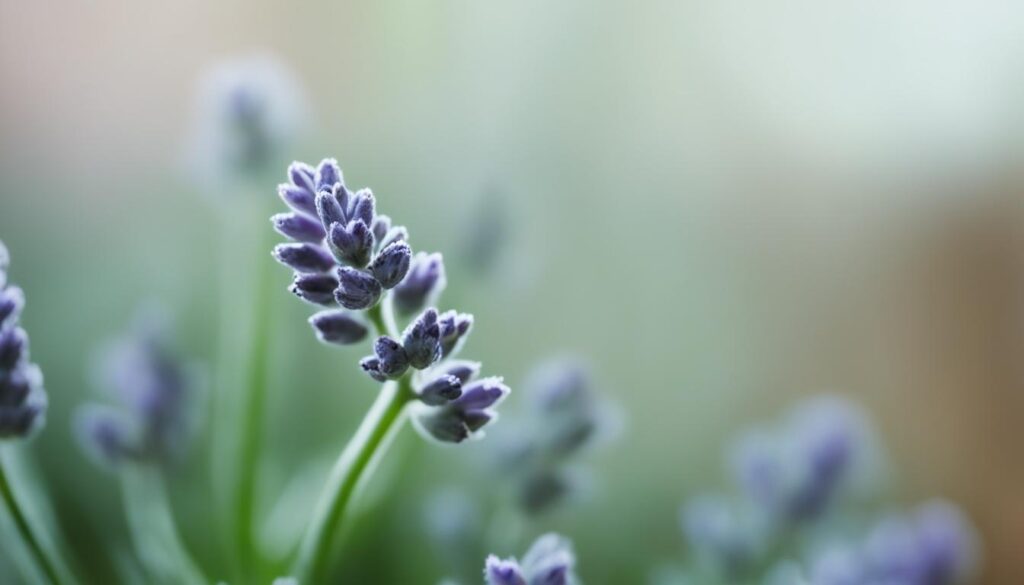
“Lavender, with its oil production, serves as a natural bug repellent against flies, moths, beetles, mosquitoes, fleas, and other insects.”
Lavender can also get diseases if not taken care of. The right growing conditions, like enough light, air, and well-draining soil, can prevent diseases like root rot or fungal infections.
By being careful and taking action early, you can enjoy your indoor lavender plant for many years.
Overwintering Lavender Plants
As the weather gets colder and days shorter, it’s time to bring your indoor lavender inside for winter. Proper overwintering care is key to making sure your lavender plants survive the cold months. They’ll come back strong in the spring.
Before the first frost, carefully move your potted lavender to a spot that gets lots of sunlight. This could be a south-facing windowsill, a sunroom, or a greenhouse. Cut back on watering and keep the temperature cool at night, between 45-50°F (7-10°C). This helps the plant go into its natural sleep.
- True English lavender (Lavandula angustifolia) can handle temperatures down to -15°C.
- French and Spanish lavender need more protection from frost.
- Move lavender in containers inside before the first frost for overwintering.
In early spring, slowly get your lavender used to being outside again before putting it back in the garden or a bigger pot. This step is important to prevent shock and help your plant do well in the warmer months.
“Proper overwintering care is the key to keeping your indoor lavender healthy and happy through the winter months.”
By doing these easy steps, you can make sure your lavender plants make it through the winter. They’ll give you lots of fragrant flowers next year. With a bit of care for your lavender in winter, you can enjoy this versatile herb all year.
Lavender Propagation Techniques
Growing New Lavender Plants from Cuttings
Lavender is easy to grow from stem cuttings. This method lets you propagate lavender and increase your indoor plants with little work. The best time for cuttings is between June and September.
To start, cut 3-inch pieces from the top of your lavender stems. Remove the leaves from the bottom inch. Then, put the cuttings in a moist, sandy potting mix. Keep them in a warm, humid spot.
With patience, roots will start to grow in 4-6 weeks. This lets you grow lavender from cuttings and share with friends and family.
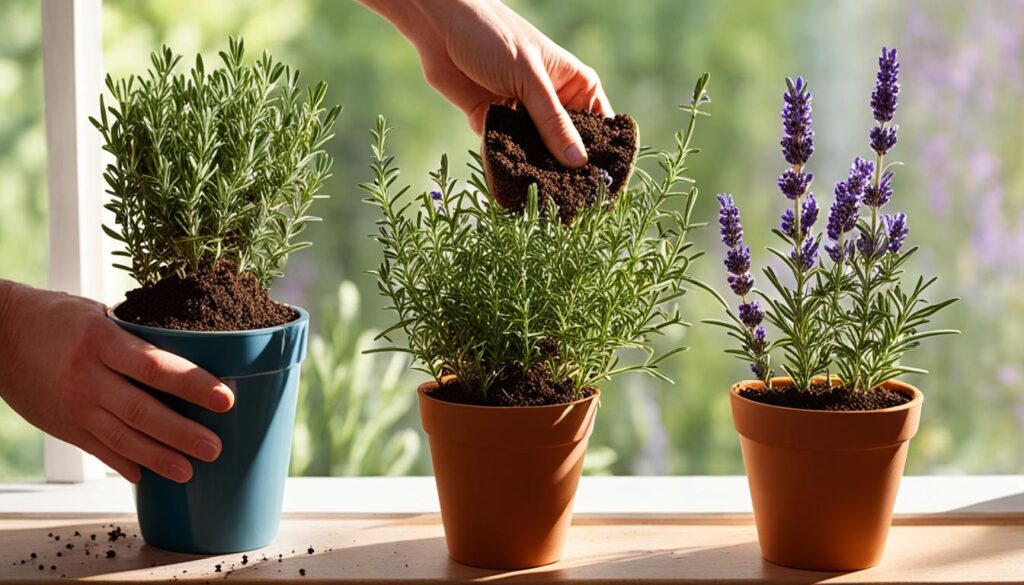
This way of multiplying indoor lavender is great for growing your collection. By learning how to propagate lavender, you can enjoy and share your lush, vibrant lavender plants.
Design Ideas for Indoor Lavender
Lavender’s fragrant purple flowers and gray-green foliage are perfect for decorating with indoor lavender. It’s a versatile herb that can brighten up your home with its look and smell. You can use it to add a calming scent or a touch of natural beauty indoors.
One easy way to use lavender is by placing potted plants in sunny spots or on shelves. The bright purple flowers and silver-green leaves make any room look better. Grouping several plants together creates a lush, fragrant display.
- Arrange lavender plants in decorative pots or planters on windowsills or side tables
- Cluster several lavender plants together to create a stunning indoor garden
- Incorporate lavender into mixed planters with other herbs or succulents
You can also use dried lavender for home decor. Make wreaths, bouquets, or sachets to hang or place around the house. Dried lavender adds a calming scent and natural beauty to your space.
“Lavender is the ultimate multitasker – it looks gorgeous, smells divine, and can even be used in cooking and crafting.”
Whether you prefer live plants or dried lavender, this herb can make any indoor space special. Try different ideas to find the best way to add this natural beauty to your home.
Common Growing Problems
Growing lavender houseplants can be rewarding, but they face some common challenges. Knowing these issues and fixing them quickly is crucial for a healthy lavender plant.
One big issue with indoor lavender is not getting enough sunlight. These plants need lots of bright, direct sunlight to do well. Without enough light, they grow weak and don’t flower much. Putting them in a sunny window or using extra lights can solve this problem.
Too much water or poor drainage can also harm lavender indoor plants. Too much moisture can cause root rot, which is bad for the plant. Make sure the soil dries out between waterings and use containers that drain well to fix this issue.
- Pests like whiteflies and spider mites can harm indoor lavender too. They make the plant look bad, stunt its growth, and can even kill it if not stopped.
- Not having enough nutrients in the soil can also hurt growing lavender indoors. This can make leaves turn yellow, growth slow down, or show other signs of trouble.
Watching your lavender plant closely and fixing any problems fast is key to keeping it healthy. By understanding and dealing with common lavender houseplant issues, you can make sure your indoor lavender stays beautiful and fragrant.
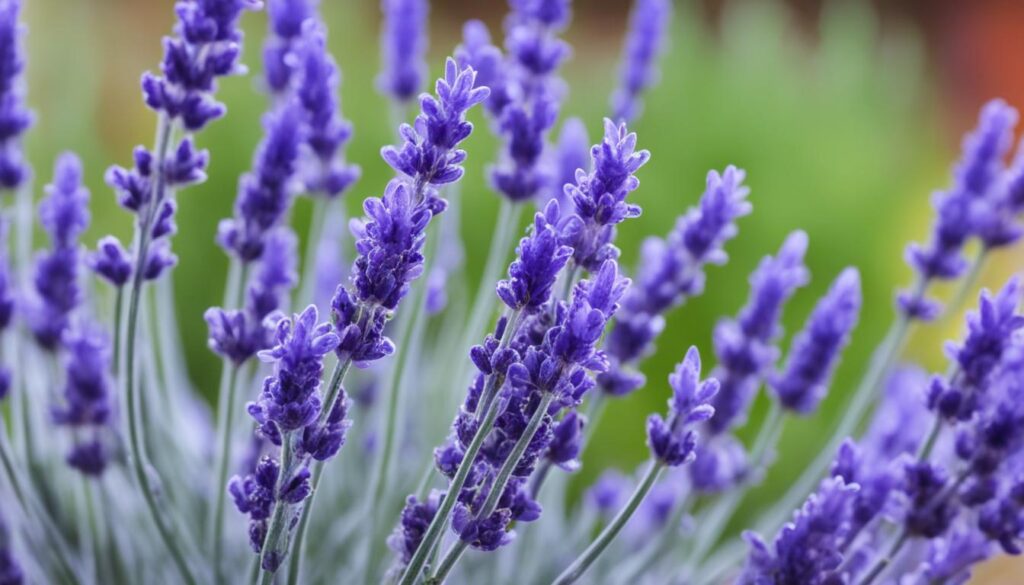
“The key to successfully growing lavender indoors is being vigilant and responsive to any signs of trouble. By addressing problems quickly, you can keep your indoor lavender plant healthy and vibrant.”
Conclusion
With the right growing conditions and care, growing lavender indoors can be rewarding and aromatic. You need to give it enough sunlight, proper lavender houseplant care, and the right temperature and humidity. This way, you can enjoy the calming presence of lavender in your home all year.
This guide has given you the key tips for indoor lavender. It helps you grow and keep this fragrant plant. By following these practices, your lavender houseplant will thrive and add natural beauty to your space.
With the right care and attention, your indoor lavender can flourish. It becomes a soothing and visually appealing part of your home. Embrace the restorative power of this versatile plant and enjoy the calming benefits it brings to your daily life.
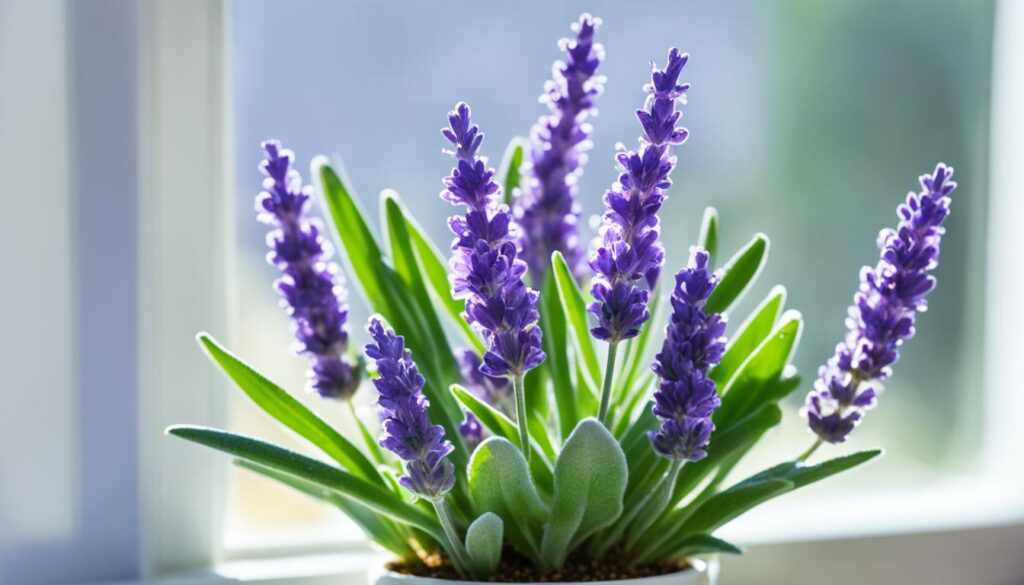
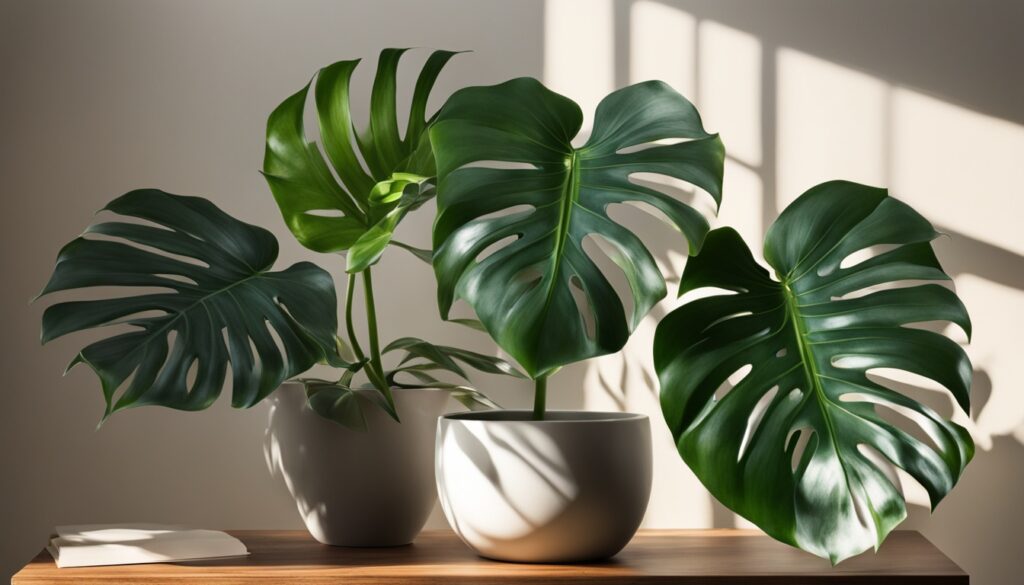

Pingback: How to care for an indoor lavender house plant?
Can you be more specific about the content of your article? After reading it, I still have some doubts. Hope you can help me.